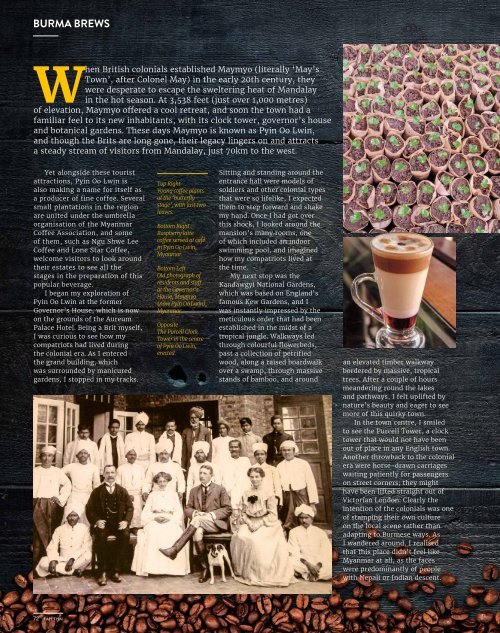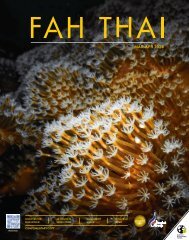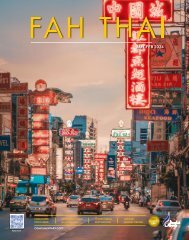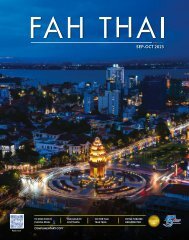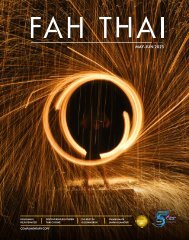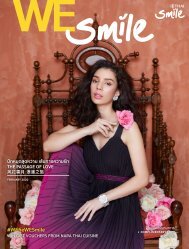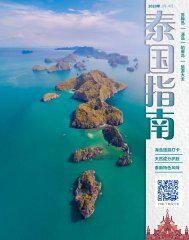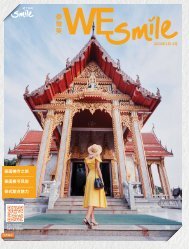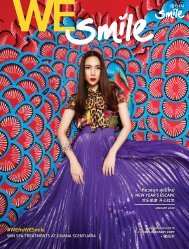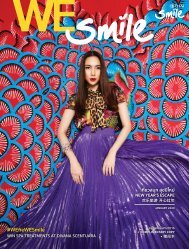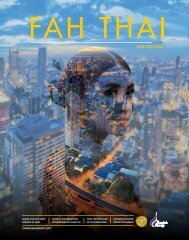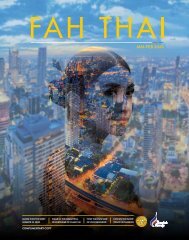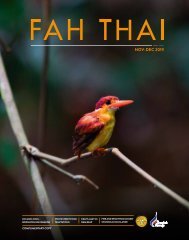Fah Thai Magazine May June 2018
Read FAH THAI MAGAZINE Online! Fah Thai is the inflight magazine of Bangkok Airways. We also come in a digital format. You can read us at Fahthaimag.com
Read FAH THAI MAGAZINE Online! Fah Thai is the inflight magazine of Bangkok Airways. We also come in a digital format. You can read us at Fahthaimag.com
Create successful ePaper yourself
Turn your PDF publications into a flip-book with our unique Google optimized e-Paper software.
BURMA BREWS<br />
When British colonials established <strong>May</strong>myo (literally ‘<strong>May</strong>’s<br />
Town’, after Colonel <strong>May</strong>) in the early 20th century, they<br />
were desperate to escape the sweltering heat of Mandalay<br />
in the hot season. At 3,538 feet (just over 1,000 metres)<br />
of elevation, <strong>May</strong>myo offered a cool retreat, and soon the town had a<br />
familiar feel to its new inhabitants, with its clock tower, governor’s house<br />
and botanical gardens. These days <strong>May</strong>myo is known as Pyin Oo Lwin,<br />
and though the Brits are long gone, their legacy lingers on and attracts<br />
a steady stream of visitors from Mandalay, just 70km to the west.<br />
Yet alongside these tourist<br />
attractions, Pyin Oo Lwin is<br />
also making a name for itself as<br />
a producer of fine coffee. Several<br />
small plantations in the region<br />
are united under the umbrella<br />
organisation of the Myanmar<br />
Coffee Association, and some<br />
of them, such as Ngu Shwe Lee<br />
Coffee and Lone Star Coffee,<br />
welcome visitors to look around<br />
their estates to see all the<br />
stages in the preparation of this<br />
popular beverage.<br />
I began my exploration of<br />
Pyin Oo Lwin at the former<br />
Governor’s House, which is now<br />
on the grounds of the Aureum<br />
Palace Hotel. Being a Brit myself,<br />
I was curious to see how my<br />
compatriots had lived during<br />
the colonial era. As I entered<br />
the grand building, which<br />
was surrounded by manicured<br />
gardens, I stopped in my tracks.<br />
Top Right<br />
Young coffee plants<br />
at the ‘butterfly<br />
stage’, with just two<br />
leaves.<br />
Bottom Right<br />
Raspberry latte<br />
coffee served at café<br />
in Pyin Oo Lwin,<br />
Myanmar.<br />
Bottom Left<br />
Old photograph of<br />
residents and staff<br />
at the Governor’s<br />
House, <strong>May</strong>myo<br />
(now Pyin Oo Lwin),<br />
Myanmar.<br />
Opposite<br />
The Purcell Clock<br />
Tower in the centre<br />
of Pyin Oo Lwin,<br />
erected.<br />
Sitting and standing around the<br />
entrance hall were models of<br />
soldiers and other colonial types<br />
that were so lifelike, I expected<br />
them to step forward and shake<br />
my hand. Once I had got over<br />
this shock, I looked around the<br />
mansion’s many rooms, one<br />
of which included an indoor<br />
swimming pool, and imagined<br />
how my compatriots lived at<br />
the time.<br />
My next stop was the<br />
Kandawgyi National Gardens,<br />
which was based on England’s<br />
famous Kew Gardens, and I<br />
was instantly impressed by the<br />
meticulous order that had been<br />
established in the midst of a<br />
tropical jungle. Walkways led<br />
through colourful flowerbeds,<br />
past a collection of petrified<br />
wood, along a raised boardwalk<br />
over a swamp, through massive<br />
stands of bamboo, and around<br />
an elevated timber walkway<br />
bordered by massive, tropical<br />
trees. After a couple of hours<br />
meandering round the lakes<br />
and pathways, I felt uplifted by<br />
nature’s beauty and eager to see<br />
more of this quirky town.<br />
In the town centre, I smiled<br />
to see the Purcell Tower, a clock<br />
tower that would not have been<br />
out of place in any English town.<br />
Another throwback to the colonial<br />
era were horse-drawn carriages<br />
waiting patiently for passengers<br />
on street corners; they might<br />
have been lifted straight out of<br />
Victorian London. Clearly the<br />
intention of the colonials was one<br />
of stamping their own culture<br />
on the local scene rather than<br />
adapting to Burmese ways. As<br />
I wandered around, I realised<br />
that this place didn’t feel like<br />
Myanmar at all, as the faces<br />
were predominantly of people<br />
with Nepali or Indian descent.<br />
72<br />
73


